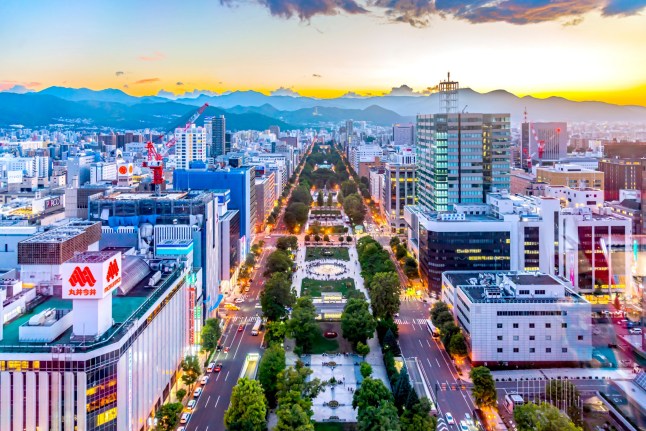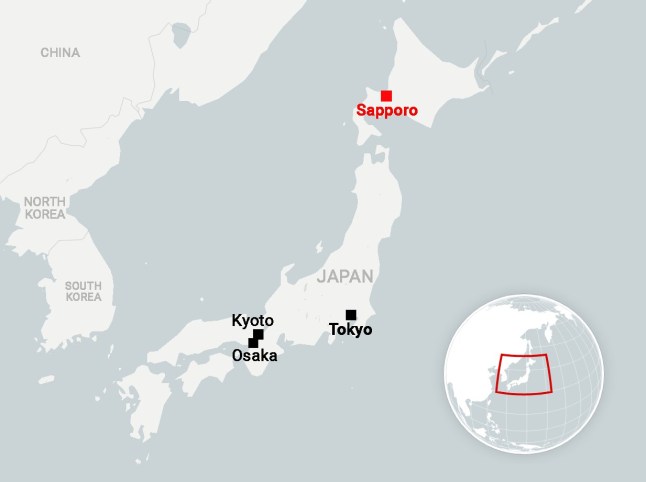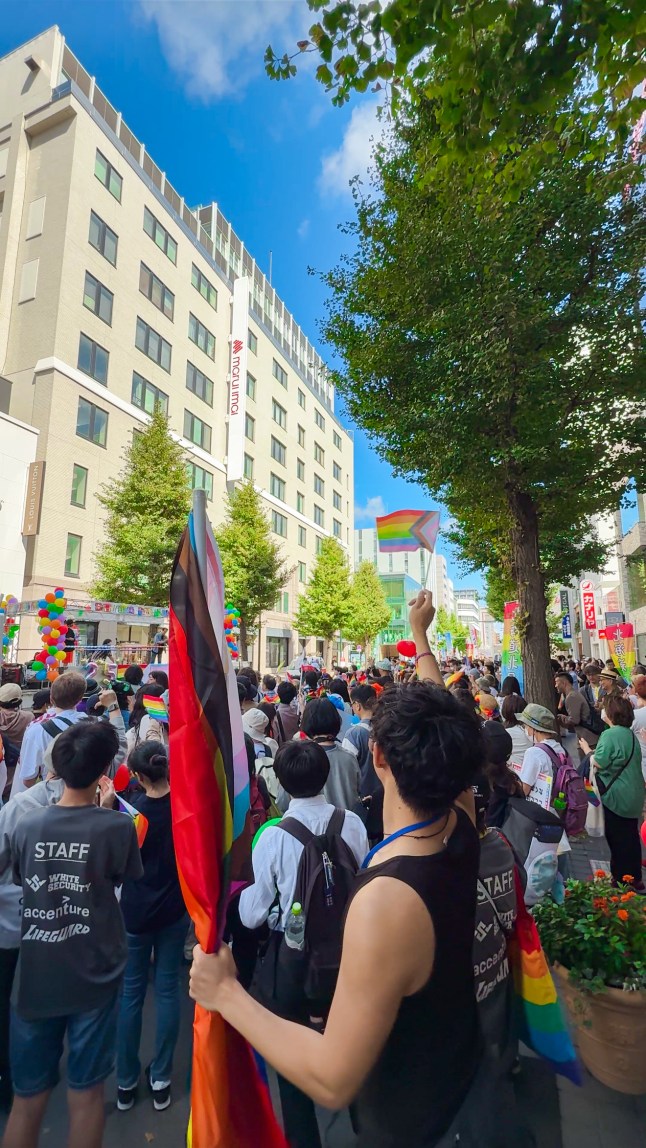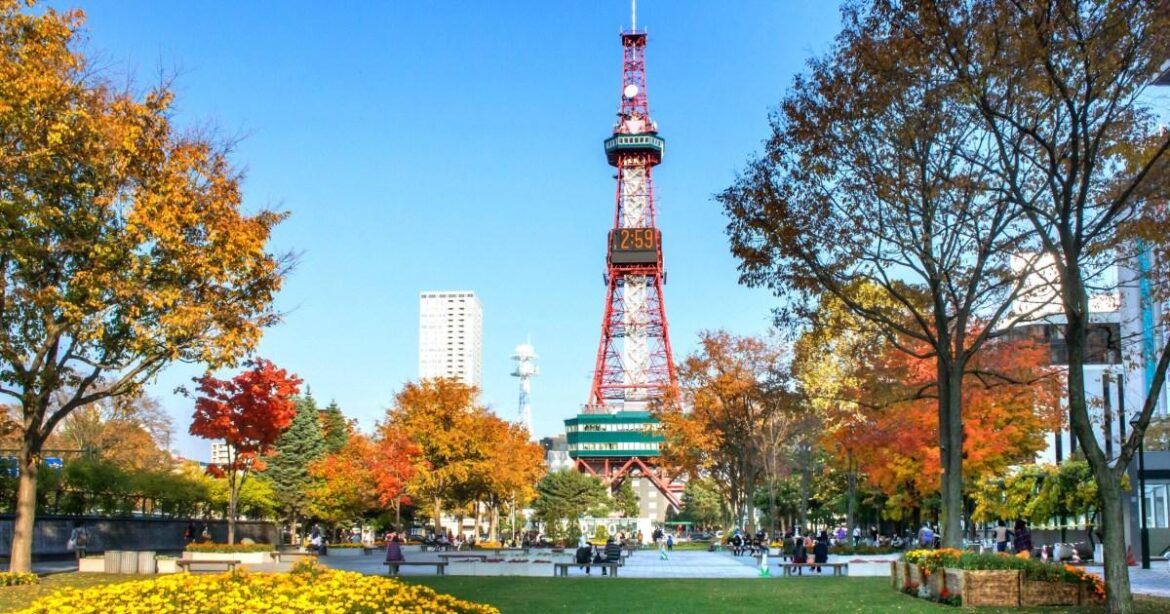
Sapporo has stylish cafes and a thriving nightlife that makes it a great fit for Pride (Picture: Shutterstock / IamDoctorEgg)
I feel myself choke as the train whizzes along the eastern coast of Japan, dramatic rock formations jutting out of the pacific as we wind along the Tanesashi Coast.
The sun is just beginning to dip below the horizon, and as the sunset colours stream through the window, I feel a tear escape and begin to roll down my cheek.
It’s breathtakingly beautiful, but that just makes it hurt all the more, because I’d hoped this would be our trip.
I’d hoped to be experiencing it… with him.
It felt like my heart had stopped when I first saw him in the Tokyo Pride Parade.
Amidst a crowd of colourful protestors chanting for equal marriage rights, he waved his flag proudly, smiling at passersby and then, suddenly, smiling at me.

Pride in Sapporo was supposed to be the best of the year, but it didn’t work out, romantically, at least (Picture: Calum McSwiggan)

Sapporo, a city famed for beer and skiing in northern Japan (Picture: Metro/Datawrapper)
I didn’t realise it then, but that moment was about to change the next year of my life. Despite not being able to speak the same language, we went out for dinner anyway, and before I knew it, I’d be learning Japanese and hopping on every flight to Japan that I could.
Join Metro’s LGBTQ+ community on WhatsApp
With thousands of members from all over the world, our vibrant LGBTQ+ WhatsApp channel is a hub for all the latest news and important issues that face the LGBTQ+ community.
Simply click on this link, select ‘Join Chat’ and you’re in! Don’t forget to turn on notifications!
So when I took on this project to explore how Pride is celebrated all over the world, I knew I had to come back to Pride in Japan.
I chose the northern city of Sapporo as the destination and imagined walking alongside him in the parade. A full circle moment taking us back to how we met.
I wanted to show how pride can bring two people from two very different cultures together, but sadly, things ultimately didn’t work out between us.
Pride Around the World
Calum McSwiggan, author of Eat Gay Love, is a man on a mission. He plans to spend 2025 exploring how the LGBT+ community is celebrated everywhere on Earth: 12 months, 7 continents, 20 Prides.
In an exclusive Metro series, Calum will journey from the subzero climes of Antarctica to the jewel-toned streets of Mumbai, telling the story of Pride around the world.
Follow his journey on Metro, in print and on our socials to see how Pride is done around the world.
There was no bad blood, but hearts were broken all the same, and so instead of making the journey together, I’m left taking the train alone.
I did think about cancelling the trip. Going back to Japan would feel different now, I knew it would hurt, and everything would inevitably remind me of him.
But I tried to remind myself that this project was never about him in the first place.
It’s always been about celebrating the different LGBT+ communities around the world, and having gotten to know Japanese culture intimately over the past year, I knew it was a story that I still wanted – and needed – to tell.
There’s a concept in Japanese culture called omotenashi, and I was hoping it was something I could rely on.
It’s the art of going above and beyond to make others feel welcome, and historically it’s something I’ve especially felt in Japanese queer spaces.
‘Are you here alone?’ somebody asks as I browse the vibrant stalls lining the streets of Sapporo.
I turn to see a friendly face smiling at me. In any other context, I’d assume flirtatious intentions – it is gay Pride, after all – but here the gesture seems genuine.
‘Where are you from?’ he asks, stretching out his hand, and before I even know what’s happening, he’s taking me over to meet some of his friends.
Dressed up for pride in extravagant outfits, I meet local drag queens and queer performers and end up being invited up to join them at the front of the parade.

In Japanese culture, it’s important to go above and beyond to make guests feel welcome (Picture: Calum McSwiggan)
By the time we’re at the halfway point, feelings of loneliness have evaporated. It’s not so easy to mend a broken heart, but I’m reminded that I still have family here as long as I’m with my community.
Far away from Tokyo, the parade is small but incredibly mighty. Less than 1,000 people show up to walk the streets but the rainbow display makes it feel so much bigger. The energy put out by the drag queens is enough to rival that of a small stadium alone.
And this energy is so desperately needed. The community here are still carving out a home for themselves. Pride doesn’t take over the streets like it does in many other countries, instead those marching are limited to one side of the road while traffic continues around them.
Not that many show up to cheer on the parade, either. A handful of stragglers cheer and wave, but for long stretches of the route, we see nobody.
This isn’t just the case in Sapporo either – in both Tokyo and Osaka my experience was the same.
Get ready for your next adventure
Hi, I’m Alice Murphy, Metro’s consultant travel editor.
If you love reading about new travel routes, lesser-known destinations and how travel changes us for the better, you’re in the right place.

I have visited over 50 countries (Picture: Alice Murphy)
Our weekly newsletter brings you everything from holiday inspiration to the latest travel news and hot takes.
Sign up now – and get in touch if you have a story. I want to hear it!
I was especially surprised by this in the capital – Tokyo has the largest urban population on earth, so you’d think the number of supporters would be astronomical.
And yet, the turnout is still minimal. It’s more comparable to smalltown Prides, like those in Rovaniemi or Limerick, rather than the huge celebrations I’ve come to know in similar metropolises like Sao Paulo or San Francisco.
When I tell people this, they seem surprised. Japan seems so progressive and welcoming from the outside looking in, and that’s very much been my experience every time I’ve visited too.
As an LGBT+ traveller, there’s nowhere in the world I feel safer. Tokyo has over 300 gay bars alone, that’s considerably more than any other city in the world. So how can the country be anything other than overwhelmingly accepting?
The answer to that question runs deep into cultural norms. Despite its outwardly welcoming culture, Japan is still incredibly conservative.

Pride in Sapporo was one of the smallest I’ve seen, but people still came out to support (Picture: Calum McSwiggan)
In fact, Booking.com’s 2025 equality index places the country far down the list at 66th place.
Equal rights for trans people are distinctly lacking; there’s still cultural taboos around being openly LGBT+; and same sex marriage is still being debated, with Japan’s newly elected prime minister being openly against legalisation despite mounting international pressure.
How Pride is celebrated around the world
Many of my queer Japanese friends aren’t out to their colleagues or family either – and even on gay dating apps like Grindr, I’ve noticed a much higher number of blank profiles and people looking to be discrete.
Still, acceptance is on the rise. Recent public opinion polls show that around 70% of Japanese citizens are accepting of LGBT+ identities, and courts in Tokyo and Sapporo recently ruled that the ban on same-sex marriage is unconstitutional.
Culturally, there’s a leaning towards LGBT+ inclusivity too. In 2024, Japanese gay dating show The Boyfriend made headlines after its groundbreaking tender depictions of same sex intimacy that made waves around the world.
In short, Japan has yet to fully embrace LGBT+ identities, but the future looks tremendously bright.
Seeing Sapporo’s community show up so boldly only increases my optimism. ‘Sapporo is a place where the warmth of people’s hearts will always shine through,’ one of the queer locals tells me.
‘It might not be perfect, but you can be true to yourself here, without feeling the need to live up to others expectations.’
The Sapporo Pride parade is not angry or defiant – it’s perhaps the least politically charged Pride event I’ve ever attended – but they still make a powerful statement with the way they embody queer joy.
They close out the celebrations with a giant bubble release – the community gather to blow bubbles en masse, filling the sky with pockets of iridescent joy.
They show the world that the LGBT+ community makes the world that little brighter – and in a lot of ways, that’s one of the most powerful messages of all.
LGBTQ+ Guide to Sapporo Pride
Getting there
Japan Airlines offers return economy fares from London to Tokyo from £899.
Flights from Tokyo to Sapporo start at £54, but if you’re looking for a scenic adventure, I highly recommend getting a JR rail pass that allows unlimited train travel across all the trains in their network. A one week pass starts at around £260.
Where to stay:
These hotels all proudly display the Travel Proud badge after completing Booking.com’s LGBT+ inclusivity training.
What to do
Ride the Ropeway: The Mount Moiwa Ropeway is a scenic cable car that takes you up to the top of the mountain for incredible views over the city. It’s especially beautiful after sundown when the city really comes to life.
Hokkaido Shrine: Nestled in Sapporo’s Maruyama Park, this is one of the most significant Shinto shrines in Japan. It’s especially beautiful when draped in cherry blossoms or snow.
Sapporo Autumn Fest: Almost always coinciding with Sapporo pride, the Autumn Fest is one of the city’s biggest festivals, taking place every year in Odori Park.
You can find more things to do across Japan here.
Places to eat and drink
Ramen Alley: Ganso Sapporo Ramen Yokocho is a narrow neon-lit lane in the heart of the city, packed with tiny ramen shops. It’s incredibly touristy but don’t let that put you off, I’ve eaten better ramen here than anywhere else in Japan.
Seafood for breakfast: Nijo Market comes alive in the early morning when local vendors lay out an abundance of fresh Hokkaido seafood. Even if that’s not to your taste, I highly recommend checking it out just for the bustling early morning energy.
Sapporo Beer Garden: Just outside the famous beer museum, this lively spot offers bottomless jingisukan, a Hokkaido style barbecue where you grill lamb and vegetables right at the table.
Arrow
MORE: The beautiful, quiet parts of Tenerife only locals know about
Arrow
MORE: Italy’s ‘oasis of tranquility’ is a hidden gem with return flights for £33
Arrow
MORE: 9 ‘exquisite’ winter sun holidays you can still book for 2025
Comment now
Comments
Add Metro as a Preferred Source on Google
Add as preferred source
The Getaway
Fuel your wanderlust with our curated newsletter of travel deals, guides and inspiration.


AloJapan.com